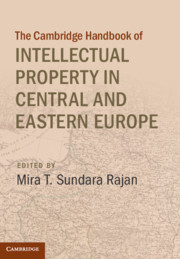Book contents
- The Cambridge Handbook of Intellectual Property in Central and Eastern Europe
- The Cambridge Handbook of Intellectual Property in Central and Eastern Europe
- Copyright page
- Dedication
- Epigraph
- Contents
- Figures
- Tables
- Contributors
- Foreword
- Acknowledgements
- 1 General Introduction – Intellectual Property in Central and Eastern Europe:
- 2 The Patent System in Pre-1989 Czechoslovakia
- 3 The Development of Hungarian Copyright Law until the Creation of the First Copyright Act (1793–1884)
- 4 Moral Rights and the Cultural Aspects of Hungarian Copyright Law:
- 5 The Polish Struggle with the Concept of Copyrightable Work:
- 6 Comparing Concepts of Originality in EU, Lithuanian, and US Law:
- 7 The Comparative Lessons of Itar-Tass Russian News Agency v. Russian Kurier
- 8 Communication to the Public under Union Law from the Perspective of Austrian and German Copyright Law: A Notion in Transition
- 9 Collective Management of Copyright in Hungary1
- 10 Exceptions and Limitations:
- 11 The Digitization of Czech Cultural Heritage and New Forms of Information Exclusivity
- 12 The Treatment of Authors’ Moral Rights in Georgia
- 13 Performers’ Rights: A Central European Export
- 14 The White Elephant in the Room:
- 15 A Central and Eastern European Perspective on EU Copyright Reform:
- 16 The Painter, the One Horn Cow, and Ole Hank Wilson’s Back Lot:
- 17 Does Paying Innovative Employees Pay Off?:
- 18 Intellectual Property Rights in Albania:
- 19 The Protection of Geographical Indications for Agricultural Products in the European Union
- 20 Legal Protection of the Traditional Knowledge and Traditional Cultural Expressions of the Indigenous Peoples of the Former Soviet Union*
- Index
13 - Performers’ Rights: A Central European Export
Published online by Cambridge University Press: 11 June 2019
- The Cambridge Handbook of Intellectual Property in Central and Eastern Europe
- The Cambridge Handbook of Intellectual Property in Central and Eastern Europe
- Copyright page
- Dedication
- Epigraph
- Contents
- Figures
- Tables
- Contributors
- Foreword
- Acknowledgements
- 1 General Introduction – Intellectual Property in Central and Eastern Europe:
- 2 The Patent System in Pre-1989 Czechoslovakia
- 3 The Development of Hungarian Copyright Law until the Creation of the First Copyright Act (1793–1884)
- 4 Moral Rights and the Cultural Aspects of Hungarian Copyright Law:
- 5 The Polish Struggle with the Concept of Copyrightable Work:
- 6 Comparing Concepts of Originality in EU, Lithuanian, and US Law:
- 7 The Comparative Lessons of Itar-Tass Russian News Agency v. Russian Kurier
- 8 Communication to the Public under Union Law from the Perspective of Austrian and German Copyright Law: A Notion in Transition
- 9 Collective Management of Copyright in Hungary1
- 10 Exceptions and Limitations:
- 11 The Digitization of Czech Cultural Heritage and New Forms of Information Exclusivity
- 12 The Treatment of Authors’ Moral Rights in Georgia
- 13 Performers’ Rights: A Central European Export
- 14 The White Elephant in the Room:
- 15 A Central and Eastern European Perspective on EU Copyright Reform:
- 16 The Painter, the One Horn Cow, and Ole Hank Wilson’s Back Lot:
- 17 Does Paying Innovative Employees Pay Off?:
- 18 Intellectual Property Rights in Albania:
- 19 The Protection of Geographical Indications for Agricultural Products in the European Union
- 20 Legal Protection of the Traditional Knowledge and Traditional Cultural Expressions of the Indigenous Peoples of the Former Soviet Union*
- Index
Summary
This chapter traces the origins of performing artists’ rights and criticizes certain concepts of performing rights. After noting the reflections on performances by Plato and Aristotle, the author introduces Jean Baptiste Say’s discussion of value of the “industry of a musician or an actor,” and the important conclusions that followed by František Ladislav Rieger. The author explains that the idea of protecting performances by means of special laws was born in Central Europe in the early 1900s. Summarizing the first cases, beginning in 1899, and the statutes protecting performers by means of traditional authors’ rights in Germany (1910), Austria, Hungary, Switzerland, Poland, and Czechoslovakia, the author compares the situation to that in the United Kingdom, which offered only criminal-law like protection, and the United States, with its fragmented case law. Finally, the author explains that the new feature of neighbouring rights and the exclusive rights of performers were “invented” by the Austrian legislator, followed, after World War II, by Czechoslovakia as the second country in the world where this was achieved, notwithstanding constant Soviet surveillance.
Keywords
- Type
- Chapter
- Information
- Publisher: Cambridge University PressPrint publication year: 2019
- 2
- Cited by

